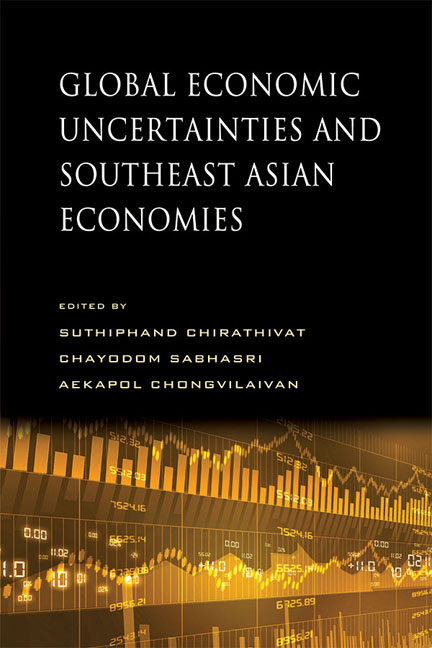Book contents
- Frontmatter
- Contents
- Preface
- Contributors
- 1 Challenges Facing a Globally Connected ASEAN
- 2 Fragile Balance of Payment in Indonesia under Global Economic Uncertainties
- 3 Malaysia in the Midst of Global Economic Uncertainties
- 4 Singapore: Reinventing Itself amid Global Economic Uncertainties
- 5 Thailand: Dependency or Diversification?
- 6 Vietnam's Economic Experience since WTO Accession
- 7 Global Economic Imbalances and Reform Policy: Evidence from Asian Economies
- 8 Foreign Exchange Rate Adjustment Policies in Asia
- 9 Monetary and Financial Architectures for ASEAN+
- 10 Global Uncertainties: Implications for the ASEAN Community
- Index
4 - Singapore: Reinventing Itself amid Global Economic Uncertainties
Published online by Cambridge University Press: 22 July 2017
- Frontmatter
- Contents
- Preface
- Contributors
- 1 Challenges Facing a Globally Connected ASEAN
- 2 Fragile Balance of Payment in Indonesia under Global Economic Uncertainties
- 3 Malaysia in the Midst of Global Economic Uncertainties
- 4 Singapore: Reinventing Itself amid Global Economic Uncertainties
- 5 Thailand: Dependency or Diversification?
- 6 Vietnam's Economic Experience since WTO Accession
- 7 Global Economic Imbalances and Reform Policy: Evidence from Asian Economies
- 8 Foreign Exchange Rate Adjustment Policies in Asia
- 9 Monetary and Financial Architectures for ASEAN+
- 10 Global Uncertainties: Implications for the ASEAN Community
- Index
Summary
INTRODUCTION
The sub-prime crisis that began in the U.S. housing market in 2007 snowballed into a global financial and economic crisis and is described as the most serious crisis to hit the global economy since the Great Depression. The contagion of the crisis transmitted from the financial sector to the real sector through demand slump, production plunge, unemployment rise and credit seize. Most worryingly, world trade — the main channel of crisis transmission — fell sharply. The GDP growth rates fell for both advanced and developing economies, leading to first-time contraction in global GDP since World War II. The crisis forced countries around the world to come up with aggressive and unconventional monetary and fiscal policy measures. There were several instances of coordinated policy actions by the central banks, which helped to avert an escalation of the crisis and prevented a meltdown of financial systems.
The crisis also busted the myth that Asia was sufficiently decoupled from the Western financial systems and that it had become independent from the cyclical developments of the global economy (Yung 2011). This is reflected in empirical data which suggest that Asia has not been immune as indicated by losses to financial institutions in the region, impacts on the stock market, and widening sovereign spreads in the region.
Singapore was no different from most of the Asian economies. It was the first East Asian nation to fall into recession, reflecting the vulnerability of the economy to global economic shocks. In 2008, GDP slumped due to a contraction in manufacturing activity in the second quarter, which subsequently extended to construction and a broad range of services. Its year-on-year real growth rate had plunged from 9 per cent in 2007 to 1.7 per cent in 2008 and further to –0.8 per cent in 2009 (see Figure 4.1).
This prompted the policymakers of Singapore to come up with a series of fiscal and monetary policy measures that helped the city-state economy to catapult itself out of recession in the third quarter of 2009.
Given this background, this chapter seeks to summarize the effects of the 2008 global financial crisis (GFC) on Singapore, and analyses the government's policy response to the same. In the latter half it discusses Singapore's economic outlook in the face of continuing global economic uncertainties, and evaluates how the island nation is faring in light of the government's recent measures to revitalize the economy.
- Type
- Chapter
- Information
- Global Economic Uncertainties and Southeast Asian Economies , pp. 77 - 105Publisher: ISEAS–Yusof Ishak InstitutePrint publication year: 2015



